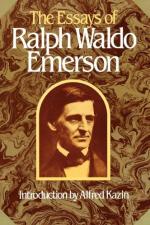[Footnote 179: Give examples of men who have been made to feel the displeasure of the world for their nonconformity.]
[Footnote 180: “Nihil tam incertum nec tam inaestimabile est quam animi multitudinis.”—LIVY, xxxi. 34.
“Mobile mutatur semper
cum principe vulgus.”
CLAUDIANUS,
De IV. Consul. Honorii, 302.
]
[Footnote 181: The other terror. The first, conformity, has just been treated.]
[Footnote 182: Consistency. Compare, on the other hand, the well-known saying, “Consistency, thou art a jewel.”]
[Footnote 183: Orbit, course in life.]
[Footnote 184: Somewhat, something.]
[Footnote 185: See Genesis, xxxix. 12.]
[Footnote 186: Pythagoras (fl. about 520 B.C.), a Greek philosopher. His society was scattered and persecuted by the fury of the populace.]
[Footnote 187: Socrates (470?-399 B.C.), the great Athenian philosopher, whose teachings are the subject of most of Plato’s writings, was accused of corrupting the youth, and condemned to drink hemlock.]
[Footnote 188: Martin Luther (1483-1546) preached against certain abuses of the Roman Catholic Church and was excommunicated by the Pope. He became the leader of the Protestant Reformation.]
[Footnote 189: Copernicus (1473-1543) discovered the error of the old Ptolemaic system of astronomy and showed that the sun is the centre of our planetary system. Fearing the persecution of the church, he hesitated long to publish his discovery, and it was many years after his death before the world accepted his theory.]
[Footnote 190: Galileo (1564-1642), the famous Italian astronomer and physicist, discoverer of the satellites of Jupiter and the rings of Saturn, was thrown into prison by the Inquisition.]
[Footnote 191: Sir Isaac Newton. (See note 53.)]
[Footnote 192: Andes, the great mountain system of South America.]
[Footnote 193: Himmaleh, Himalaya, the great mountain system of Asia.]
[Footnote 194: Alexandrian stanza. The Alexandrian line consists of twelve syllables (iambic hexameter). Neither the acrostic nor the Alexandrine has the property assigned to it here. A palindrame reads the same forward as backward, as:
“Madam,
I’m Adam”;
“Signa te signa; temere
me tangis et angis”;
or the inscription on the church of St. Sophia, Constantinople:
[Greek: “Nipson anomemata me monan opsin,”]
]
[Footnote 195: The reference is to sailing vessels, of course.]
[Footnote 196: Scorn eyes, scorn observers.]
[Footnote 197: Chatham, William Pitt, Earl of Chatham (1708-1778), this distinguished statesman and orator. He became very popular as a statesman and was known as “The Great Commoner.”]
[Footnote 198: Adams. The reference is presumably to Samuel Adams (1722-1803), a popular leader and orator in the cause of American freedom. He was a member of the Continental Congress and a signer of the Declaration of Independence. Emerson may have in mind, however, John Adams (1735-1826), second president of the United States.]




